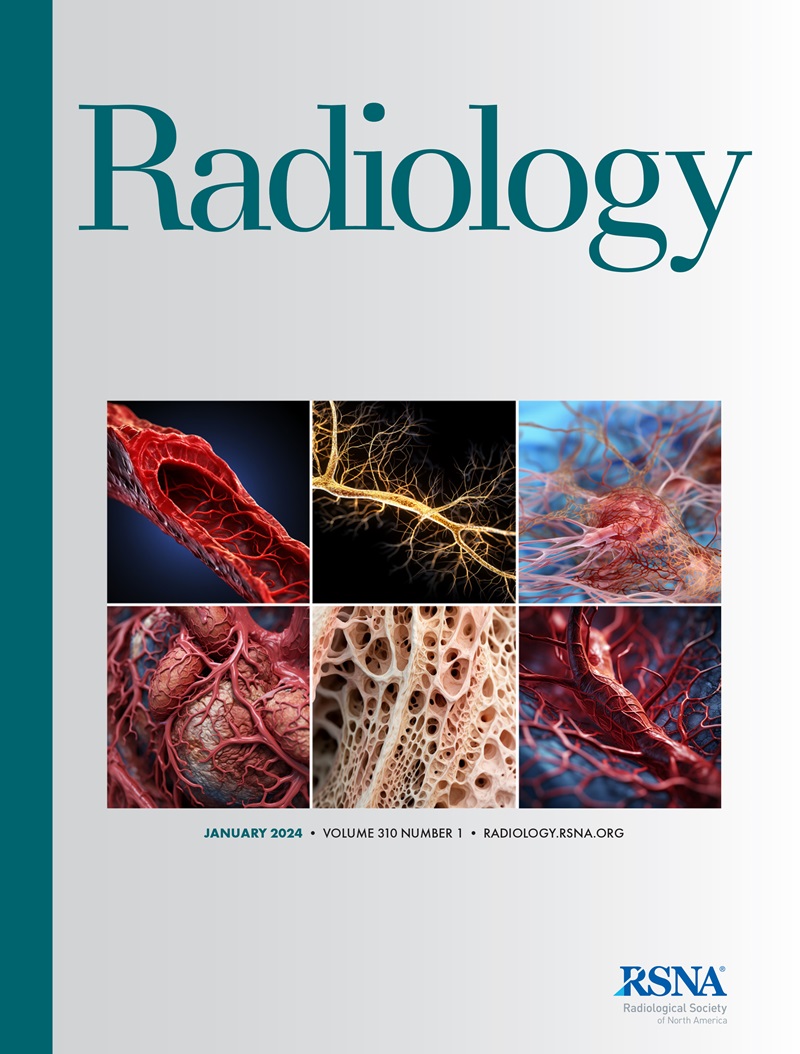下载PDF
{"title":"Changes in Reader Performance During Sequential Reading of Breast Cancer Screening Digital Breast Tomosynthesis Examinations.","authors":"Craig K Abbey, Andriy I Bandos, Mohana K Parthasarathy, Michael A Webster, Margarita L Zuley","doi":"10.1148/radiol.232885","DOIUrl":null,"url":null,"abstract":"<p><p>Background Studies suggest that readers experience perceptual adaptation when interpreting batched screening mammograms, which may serve as a mechanism for improved performance. Purpose To analyze clinical digital breast tomosynthesis (DBT) screening data to evaluate changes in reader performance during sequential batch reading. Materials and Methods This observational retrospective study used data from the radiology information system collected for screening DBT examinations performed from January 2018 to December 2019. The reference standard was established based on pathology results, if applicable, or imaging findings at 1-year follow-up. Examinations were aggregated into batches, defined as a sequence of cases for a given reader with differences in interexamination time of 10 minutes or less. Mixed-effect models were used to evaluate performance and timing across batch positions. Statistical adjustments accounted for potential confounders, including patient characteristics (age, breast density), reading factors (day of week, time of day), and between-reader heterogeneity. Results The dataset included 121 652 examinations (median patient age, 61 years [IQR, 53-69 years]), including 1081 cancers interpreted by 15 radiologists. Unadjusted false-positive rates decreased from an averaged 15.5% at the first within-batch examination to 10.5% after three sequentially read examinations (<i>P</i> < .001), without a significant change in sensitivity (82.6% vs 84.2%; <i>P</i> = .15). The interpretation time consistently decreased, achieving a substantial reduction in longer batches (average 2.8 to 2.2 minutes for noncancer examinations; <i>P</i> < .001). Adjustment for sampling bias and confounders (patient age, breast density, day of week, time of day; all <i>P</i> < .005) reduced the effect on false-positive rates (11.5% to 9.4% after three examinations; <i>P</i> < .001) and interpretation time (3.2 to 2.7 minutes for noncancer examinations; <i>P</i> < .001). Conclusion Radiologists showed improved recall rates and interpretation times without change in sensitivity over the course of batch reading of DBT screening examinations. © RSNA, 2024 See also the editorial by Iima and Satake in this issue.</p>","PeriodicalId":20896,"journal":{"name":"Radiology","volume":"313 2","pages":"e232885"},"PeriodicalIF":12.1000,"publicationDate":"2024-11-01","publicationTypes":"Journal Article","fieldsOfStudy":null,"isOpenAccess":false,"openAccessPdf":"https://www.ncbi.nlm.nih.gov/pmc/articles/PMC11605108/pdf/","citationCount":"0","resultStr":null,"platform":"Semanticscholar","paperid":null,"PeriodicalName":"Radiology","FirstCategoryId":"3","ListUrlMain":"https://doi.org/10.1148/radiol.232885","RegionNum":1,"RegionCategory":"医学","ArticlePicture":[],"TitleCN":null,"AbstractTextCN":null,"PMCID":null,"EPubDate":"","PubModel":"","JCR":"Q1","JCRName":"RADIOLOGY, NUCLEAR MEDICINE & MEDICAL IMAGING","Score":null,"Total":0}
引用次数: 0
引用
批量引用
Abstract
Background Studies suggest that readers experience perceptual adaptation when interpreting batched screening mammograms, which may serve as a mechanism for improved performance. Purpose To analyze clinical digital breast tomosynthesis (DBT) screening data to evaluate changes in reader performance during sequential batch reading. Materials and Methods This observational retrospective study used data from the radiology information system collected for screening DBT examinations performed from January 2018 to December 2019. The reference standard was established based on pathology results, if applicable, or imaging findings at 1-year follow-up. Examinations were aggregated into batches, defined as a sequence of cases for a given reader with differences in interexamination time of 10 minutes or less. Mixed-effect models were used to evaluate performance and timing across batch positions. Statistical adjustments accounted for potential confounders, including patient characteristics (age, breast density), reading factors (day of week, time of day), and between-reader heterogeneity. Results The dataset included 121 652 examinations (median patient age, 61 years [IQR, 53-69 years]), including 1081 cancers interpreted by 15 radiologists. Unadjusted false-positive rates decreased from an averaged 15.5% at the first within-batch examination to 10.5% after three sequentially read examinations (P < .001), without a significant change in sensitivity (82.6% vs 84.2%; P = .15). The interpretation time consistently decreased, achieving a substantial reduction in longer batches (average 2.8 to 2.2 minutes for noncancer examinations; P < .001). Adjustment for sampling bias and confounders (patient age, breast density, day of week, time of day; all P < .005) reduced the effect on false-positive rates (11.5% to 9.4% after three examinations; P < .001) and interpretation time (3.2 to 2.7 minutes for noncancer examinations; P < .001). Conclusion Radiologists showed improved recall rates and interpretation times without change in sensitivity over the course of batch reading of DBT screening examinations. © RSNA, 2024 See also the editorial by Iima and Satake in this issue.
乳腺癌筛查数字乳腺断层合成检查顺序阅读过程中阅读者表现的变化。
背景 研究表明,读者在解读成批筛查乳腺 X 光片时会出现知觉适应,这可能是提高性能的机制。目的 分析临床数字乳腺断层扫描(DBT)筛查数据,评估连续批量读片过程中读片人员表现的变化。材料和方法 这项观察性回顾研究使用了放射学信息系统中收集的数据,这些数据用于 2018 年 1 月至 2019 年 12 月期间进行的筛查 DBT 检查。参考标准根据病理结果(如适用)或 1 年随访时的成像结果确定。检查被汇总成批,定义为特定阅读器的一系列病例,检查间时间差不超过 10 分钟。混合效应模型用于评估不同批次位置的性能和时间。统计调整考虑了潜在的混杂因素,包括患者特征(年龄、乳腺密度)、阅读因素(星期、时间)和阅读器之间的异质性。结果 数据集包括 121 652 例检查(患者年龄中位数为 61 岁 [IQR,53-69 岁]),其中包括由 15 位放射科医生判读的 1081 例癌症。未经调整的假阳性率从第一次批内检查时的平均 15.5% 下降到三次连续读片检查后的 10.5%(P < .001),灵敏度没有显著变化(82.6% vs 84.2%;P = .15)。判读时间持续缩短,在较长的批次中实现了大幅缩短(非癌症检查从平均 2.8 分钟缩短到 2.2 分钟;P < .001)。对抽样偏差和混杂因素(患者年龄、乳腺密度、星期几、一天中的时间;均 P < .005)进行调整后,对假阳性率(三次检查后从 11.5% 降至 9.4%;P < .001)和判读时间(非癌症检查从 3.2 分钟降至 2.7 分钟;P < .001)的影响降低了。结论 在对 DBT 筛查检查进行批量读片的过程中,放射科医生的召回率和判读时间都有所改善,但灵敏度没有变化。RSNA, 2024 另请参阅本期 Iima 和 Satake 的社论。
本文章由计算机程序翻译,如有差异,请以英文原文为准。


